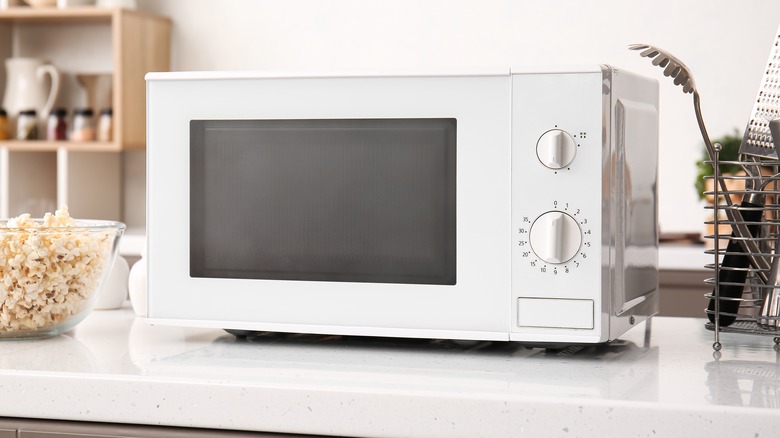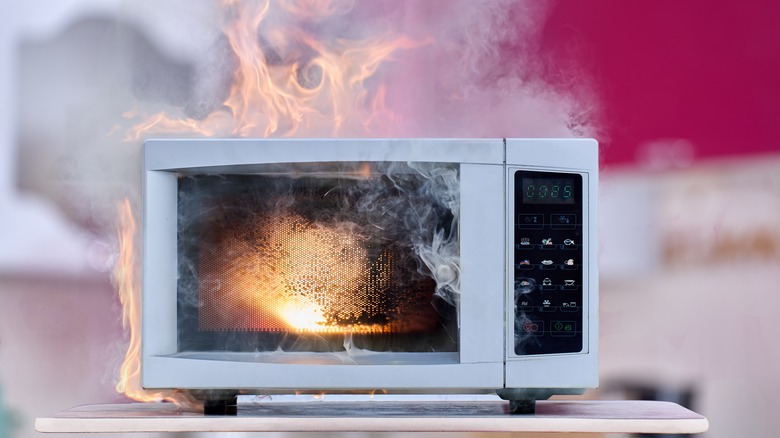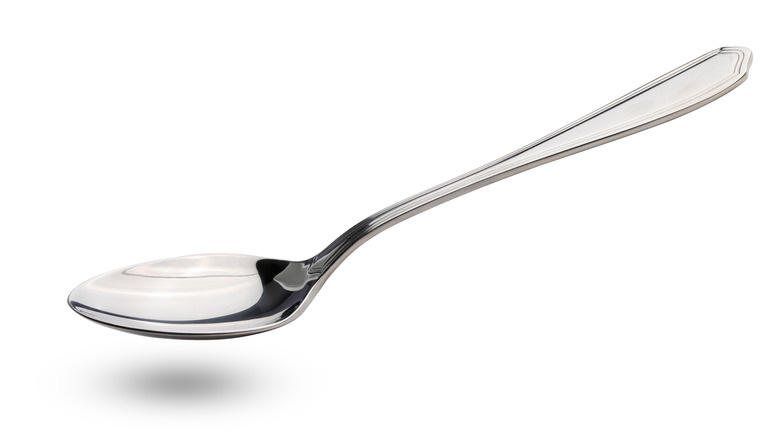Why Putting Metal In The Microwave Can Be Dangerous
The microwave oven is a miracle of modern convenience, breathing new life into leftovers, revolutionizing the frozen food industry, and giving rise to countless kitchen hacks. But the microwave isn't without its drawbacks, as you'll surely know if you've ever tried to reheat something wrapped in tinfoil. You'd think heating up that leftover burrito would be the simplest thing on Earth, but that foil package can unleash holy hell in your microwave — sparks will fly, crackling like a bonfire, and in the worst case scenario, your meal can literally go down in flames.
"Don't put metal in the microwave" is common wisdom in this day and age, but if that's the case, why do so many microwaves come with a metal rack? Why do Hot Pockets, a food specifically designed for the microwave, come in a metal-lined pouch? And most baffling of all, if microwaves are so dangerous for metal, then why is every microwave oven made from a big metal box? It doesn't make sense ... until you dive into the science.
It turns out that there are certain metal objects that you can put in the microwave and certain ones that you absolutely should not. To determine the difference, you must answer two questions. Firstly, how thick is the metal? And secondly, how smooth is it? Thick and smooth metal objects are fine for the microwave, but thin and jagged ones, like tinfoil or the tines of a fork, are a disaster in the making. Here's why.
Metal can't absorb microwave energy
Before we dive any deeper into the particulars of different objects, we need a quick primer on how microwaves actually work. The heart of every microwave is a magnetron, which, despite sounding like the name of a Transformers character, is actually a device that generates electromagnetic waves. Specifically, it generates microwaves (thanks, Captain Obvious), which go bouncing around the inside of the oven. Food absorbs some of these microwaves, which cause the water molecules in said food to vibrate so much that they generate heat, warming up your meal.
Metal cannot absorb microwaves, as it contains no water to transfer the energy to. Most of the microwaves that come into contact with metal get reflected right back, which is why the inside of every microwave is a metal box: It reflects microwaves back into the oven and keeps them from escaping. It's also why Hot Pockets come in a metal-lined sleeve. That sleeve helps to direct energy into the food.
The problem with metal is that it also contains a lot of freely-moving electrons that get agitated by microwaves. This can lead to disaster when metal that is either thin and/or jagged, such as a fork or crumpled aluminum foil, is put in a microwave oven. Those pointy edges become dead ends where electrons build up. When the charge becomes too extreme, electrons start flying off into the air, creating sparks. If a spark touches something flammable, you'll have a fire on your hands.
Not all metal objects react the same in the microwave
Not all metal objects pose the same threat that foil and forks do. Generally speaking, pieces of metal that are thick and smooth can go through the microwave just fine. The key to the lining of a Hot Pocket sleeve is that the metal is completely smooth. If it got crumpled up, creating little edges, you'd have a problem on your hands. It's the same reason that a smooth-edged spoon can handle a microwave while a pointy fork cannot.
So, some metal objects are fine for the microwave, but even then, you should never microwave metal alone. Why anyone would wish to do so is a mystery, but what's certain is the disaster that can follow. If, say, a spoon was microwaved, it would reflect microwaves back out into the oven, and with no food to absorb them, they'd just keep bouncing around. Meanwhile, the magnetron would keep pumping out radiation, and eventually so much would build up inside the microwave that it could fry the circuitry. The same does not apply to glass, paper, ceramic, and plastic containers, because microwaves pass right through these materials with no effect. In the end, it's probably best to just keep metal objects out of the microwave.


